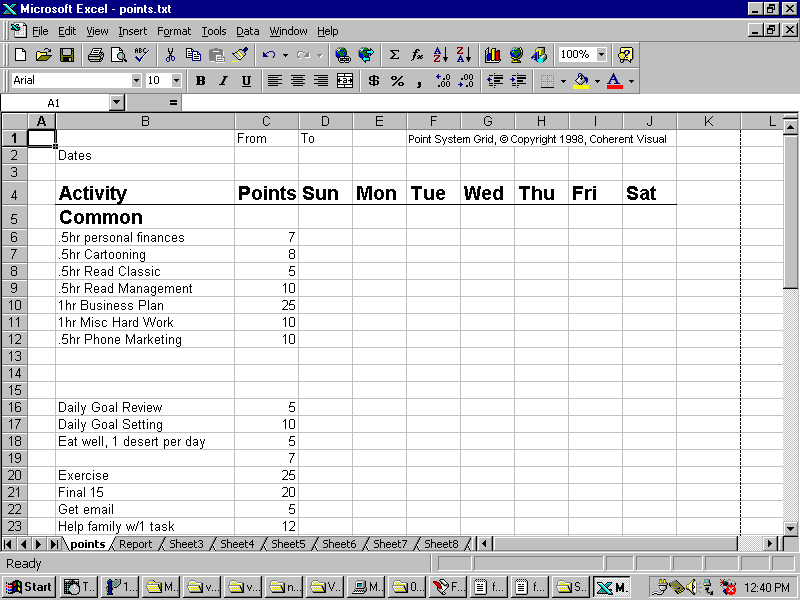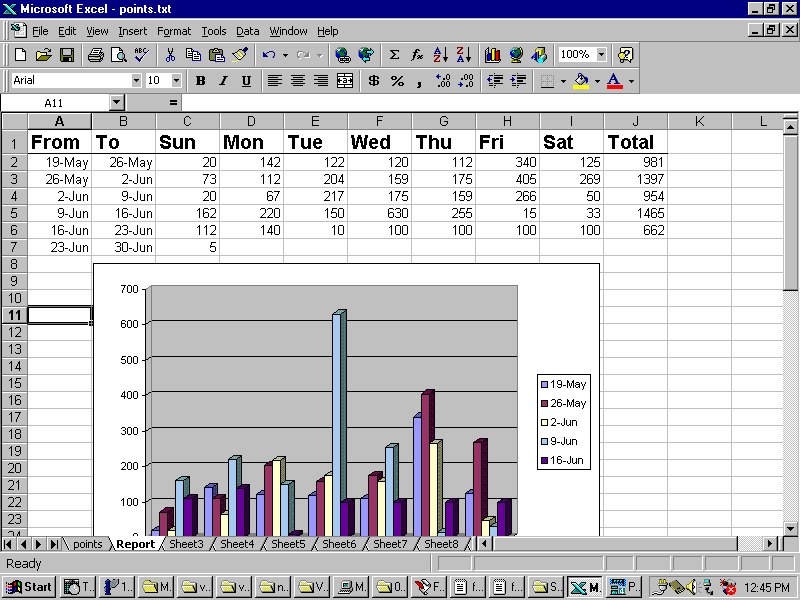The Points System
I originally created the point system to help me continue working despite the heavy workload I was under. You know the times when it seems like you're working so hard, but not getting anything done? Using the Point System gives you a way of making progress, competing with yourself from day to day, and allows you to measure things that are difficult to measure.
 With the Points
System, you get points credit for every task you achieve. You set the values of particular
tasks based on their importance toward achieving what you want to do. If there is a task
that you've procrastinate on, you can increase the point value of that task to get you to
do it.
With the Points
System, you get points credit for every task you achieve. You set the values of particular
tasks based on their importance toward achieving what you want to do. If there is a task
that you've procrastinate on, you can increase the point value of that task to get you to
do it.
By tracking the points you've earned every day, you can judge how effective you are not only at the work you're trying to accomplish, but also in estimating the amount of work you can achieve.
 After you've used the system for a
while, you will have accumulated a history of the level of work you can undertake. Using
the graphing abilities of your spreadsheet, you can visually examine your progress almost
like looking at a company sales chart or other business graphic.
After you've used the system for a
while, you will have accumulated a history of the level of work you can undertake. Using
the graphing abilities of your spreadsheet, you can visually examine your progress almost
like looking at a company sales chart or other business graphic.
Using the charts you can see trends.
The important aspect of the Points System is the ability to modify it so that you can track and further the goals that you want.
I have set up the Point System grid in a spreadsheet because that is often the most useful format. Here is essentially what the Point System grid looks like:
| Activity | Points | Mon | Tue | Wed | Thu | Fri | Sat | Sun |
| Common | ||||||||
| .5hr personal finance | 5 | |||||||
| 1hr business plan | 15 | |||||||
| Periodic | ||||||||
| Mow lawn | 25 | |||||||
| Clean garage | 20 | |||||||
| Summary | ||||||||
| Total for today | ||||||||
| Goal for today | ||||||||
| Success percentage | % | % | % | % | % | % | % | % |
The grid is divided into three parts: Common, Periodic, and Summary.
All of the common tasks (non-unique) are placed in the Common Section. These are tasks you will do again and again or many times during the day.
Tasks that are unique and only occur occasionally go in the periodic section.
Every time you complete a task in a section, you can place a check mark in the empty box.
I typically plan my day by filling the grid with underscores for everything I need to do. For example, if I want to spend two hours on personal finances on Monday, I'll place four underscores (__ __ __ __) in the Monday box. These underscores represent the half hour units for each accomplished time.
Download Excel 5.0/95 sample (48 K)
Download Tab-delimited sample (1 K)
(c) Copyright Coherent Visual, 1998